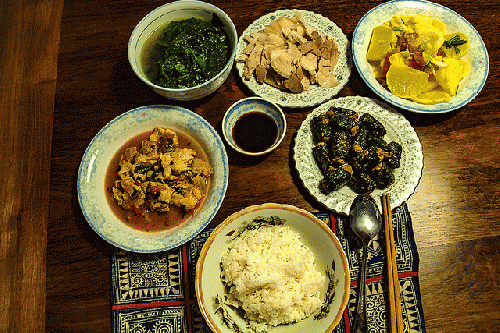I'm back in Hanoi. Noi Bai Airport was sparkling after its recent upgrade, and I rode into town on a wide, well-landscaped freeway named after general Vo Nguyen Giap. On both sides were shops and restaurants.
"I don't recognize any of this, brother," I said to the taxi driver, a man in his mid 40's.
"When was the last time you were here, uncle?" North Vietnamese routinely call each other "ba'c," or "greater uncle."
"2000."
As the Hanoi skyline finally came into view, I blurted, "I hardly know I'm in Vietnam!" Every lit sign on the highrises was in English. We crossed the Nht T n Bridge, built with a loan from Japan and designed by a Japanese firm. My driver slowed down so I could admire its five towers, illuminated in shifting colors. A native Hanoian, he'd been driving for eight years, with his finances tolerable and improving. "There are still plenty of poor people," he reminded me, "especially in far off places."
"Do you have any relatives overseas?" I asked.
"I have an aunt in Holland. She had gone to Bulgaria to work in a factory."
"And she's doing OK?"
"She's doing fine. Every two years, she comes home for a visit."
We passed two preposterous pseudo-classical gates, crowned by galloping horses. Behind them were swanky houses for the nouveau riche. All the street names in this gated community, Ciputra, sound enticingly exotic, Main, Lake, Park, Central Park, Singapore, Pegasus, Atlas and Academy, etc. On the flight in, I had sat next to a man returning from Fiji, where his wife's posted to the Vietnamese embassy. He had three kids at American universities, in Minnesota, Ohio and New York State. "I've been to a bunch of countries, uncle. Each place is interesting for 8, 10 days, then I want to go home."
Leaving the freeway, a more familiar Hanoi, and Vietnam, came into view. A typical Vietnamese street is lined with shops and restaurants, with commerce often spilling onto the sidewalk, and until very recently, there were no Vietnamese neighborhoods that were strictly residential.
On my second day, I got up just before sunrise to wander around Vinh Phuc, my neighborhood. The restaurants were just opening up. Exercising, a man in a tank top walked backward past me. Sitting on a plastic stool across the street from a funeral home, a woman worked on a red, yellow, white and crimson wreath. I noticed a Japanese language school, a fishing gear shop and the Trang Bella hair salon. At a corner, a man lounged on his motorbike, waiting for his first customer. Unlike pedicabs, motorbike taxis haven't been banned. Though it is a wonderfully cheap way to get around, its slow pace clogs traffic, so the pedicab, a major icon of Vietnam, has been killed off everywhere except in a handful of tourist areas. The North Vietnamese Army pith helmet, worn by most men during my first visit to Hanoi in 1995, is also mostly gone.
I believe that the pedicab will not only make a comeback, but spread to other countries. It's not only cheap, but green, and takes very little to start up as a business. With just a few bucks and minimal training, you too can become a pedicab driver.
In 2001, one couldn't sit in a restaurant without being hounded, repeatedly, by lottery ticker sellers, wandering in off the street, but now, there are many fewer of them, and the beggars have nearly all disappeared.
Ha, a 55-year-old domestic servant, informed me, " There are more jobs now, so people don't have to do that. There were also too many imposters, beggars who would sell the charity rice, then eat comfortably in a restaurant. They ate better than normal people!"
(Note: You can view every article as one long page if you sign up as an Advocate Member, or higher).






